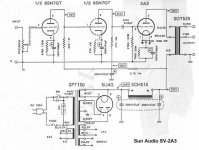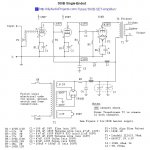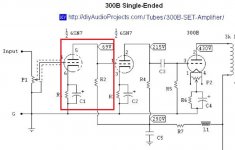Hi everyone.
I have a doubt.
Sometimes a tube such as a 5842, or D3a, or 6E6P or 6S45P or C3g is used to drive a triode such as a 45, 2a3, or 300B.
Estimating that they have gain factors between 30 and 45 times, approximately 2v input is needed.
Why are there circuits with two 12ax7 stages or two 6sn7 stages that the gain factor would be 300 times or more, to drive a triode that needs approx 160vpp to fully operate without NFB ?
I have a doubt.
Sometimes a tube such as a 5842, or D3a, or 6E6P or 6S45P or C3g is used to drive a triode such as a 45, 2a3, or 300B.
Estimating that they have gain factors between 30 and 45 times, approximately 2v input is needed.
Why are there circuits with two 12ax7 stages or two 6sn7 stages that the gain factor would be 300 times or more, to drive a triode that needs approx 160vpp to fully operate without NFB ?
Attachments
Most CD players have about +3V to -3V full scale outputs (6Vpp).
David Chesky's CDs often never get to full scale, peaks are about 10dB below that, about +1V to -1V (2Vpp).
A typical Phono preamp might output 0.5V or even 1V peaks (1Vpp or 2Vpp).
Need Gain, get gain.
David Chesky's CDs often never get to full scale, peaks are about 10dB below that, about +1V to -1V (2Vpp).
A typical Phono preamp might output 0.5V or even 1V peaks (1Vpp or 2Vpp).
Need Gain, get gain.
Last edited:
2V input sensitivity is actually far from being standard.
Most "classical" commercial hi-fi amps have ~200mV sensitivity - just about enough to cope with something like casette deck or old tuner or phono stage built into the turntable.
More recent amps tend to have 400-500mV sensitivity though.
Most "classical" commercial hi-fi amps have ~200mV sensitivity - just about enough to cope with something like casette deck or old tuner or phono stage built into the turntable.
More recent amps tend to have 400-500mV sensitivity though.
Sun Audio amp has very high gain. In fact it is an amp with an input that could be used directly as input for a line level source. It has input volume pots, too. But what it needs for a full function pre and power amp are severel different inputs and an input selector switch.
This is where the line between "integrated amp" and "power amp" gets drawn.
I would say that if you need more than 1.5V of signal to get to full power, you're more in the power amp camp. The 6SN7->6SN7->DHT arrangement does indeed have a lot more gain than is necessary, even as an integrated amp. This is made a bit worse by both amps having both driver stages with bypassed cathode resistors.
I would say that if you need more than 1.5V of signal to get to full power, you're more in the power amp camp. The 6SN7->6SN7->DHT arrangement does indeed have a lot more gain than is necessary, even as an integrated amp. This is made a bit worse by both amps having both driver stages with bypassed cathode resistors.
The intention for this low anode voltage was to have only one coupling cap in the signal chain but to use a three stage amp with a very high total gain. The same could be achieved with a pentode (WE style circuit) but when looking at the second triode stage one notices that this runs with higher current and voltages so it makes for a more beefy driver stage in comparison with the WE style pentode circuit. Its a very clever circuit which has become famous amongst 300B afficionados.
convert the voltage gain of each tube stages to db, then convert the insertion loss or turns ratio of the OPT to db, then add them all together to get the overall voltage gains...
the first valves work between 60 and 70v.
Does that make the first stage gain less?
plate voltage of the first stage, that is correct, that in turn is direct coupled to the grid of the second stage, so that the second stage cathode is several volts higher than the plate of the firs stage....
mu of the 6sn7 is 20, you may think that the voltage gain is 20, it is not, not even half of that....
This is where the line between "integrated amp" and "power amp" gets drawn.
I would say that if you need more than 1.5V of signal to get to full power, you're more in the power amp camp. The 6SN7->6SN7->DHT arrangement does indeed have a lot more gain than is necessary, even as an integrated amp. This is made a bit worse by both amps having both driver stages with bypassed cathode resistors.
removing the bypass caps in the first gain stage lowered gains and decreases distortion....
i am not sure it is wise to remove the bypass caps on the second stage...
another option is to use dual dissimilar triodes like the 6ew7 where you need not use global negative feedback...
...two 12ax7 stages or two 6sn7 stages that the gain factor would be 300 times or more....
12AX7 can be penciled as 50X per stage. Two of those is 2,500X. You should never find two cascaded 12AX7 without heavy degeneration/NFB.
6SN7/12AU7 often gives gain of 15 or 16. Two of these is 225X-250X.
A "Power Amp" usually wants 1V-1.7V to make full output (as audiowize says). A Phono Preamp may only make a Part Volt. And excess gain makes it "look like" the system has more Power than it really has (because most folks don't get the difference power or gain). So it was common to have a Line Amp with gain of 5X or 10X. Or an Integrated Amplifier (line+power) might have input sensitivity (as TG says) of 0.1V-0.2V.
Why are there circuits with two 12ax7 stages or two 6sn7 stages that the gain factor would be 300 times or more, to drive a triode that needs approx 160vpp to fully operate without NFB ?
Wait a minute...... ecc83 has µ 100 but....high ri.
that means with normal plate resistor, u get gain only 30-60 max
if u want full gain, must use fet gyrators/mu followers; 95-100% gain of mu possible ! even a cathode unbypassed...
- Home
- Amplifiers
- Tubes / Valves
- How much gain for a Triode Single end ?


